Darlington Corporation Light Railways
History
Darlington Corporation became a tramway owner on the 24th January 1902, when it purchased the town's 3ft-gauge horse tramway from its owners, the Imperial Tramways Company Limited. Although the ITCo had obtained powers in 1899 to rebuild and electrify the system, its aspirations were to come to naught as it quickly became clear that the corporation had plans of its own, the first step of which, in December 1900, was the opening of a municipal power station.
The corporation eventually acquired powers (in July 1902) to build and operate an electric tramway, in the meantime, leasing operation of its newly acquired horse tramway to a Mr C J O'Dowd. Mr O'Dowd ran the tramway for the last 19 months of its life, the last horse tram running on the 18th August 1903. For some reason, it took the corporation another 10 months before the inauguration of the new electric services — on the 2nd June 1904 — quite a hiatus for passengers, even taking into account the change of gauge to 3ft 6ins.
The system was just 4.87 miles long, and comprised four lines that converged at the Clock Tower on High Row. From High Row, lines ran northwestwards along Woodland Road to Cockerton; northwards along Northgate, North Road and Durham Road to Harrowgate Hill; and eastwards along Tubwell Row and Bridge Row to the River Skerne, after which the lines divided, one set heading northeastwards via Clay Row, Freemans Place and Haughton Road, to a terminus near Barton St, and the other set continuing eastwards along Parkgate and Yarm Road to Eastbourne. Although the corporation, and before it the ITCo, held vague hopes of building an extension eastwards to Stockton, the DCLR remained isolated all its life.
The system was well-used, the sixteen single-deck tramcars soon proving inadequate for the passenger numbers. Two new double-deck vehicles were acquired in 1913, and with loadings continuing to increase during the Great War, another six were added to the fleet, coming second-hand in 1918 from the defunct Sheerness and District Tramways, which had closed in 1917. Like many systems, the DCLR presumably suffered from the effects of the Great War, namely, heavier loadings, staff and skills shortages, and severe restrictions on spares and renewals. As such, it would have emerged from the conflict in a run-down condition (details are sparse), though as the corporation was still toying with the idea of building tramway extensions as late as 1923, it seems that it had by that time caught up on its maintenance backlog and that it, or key individuals on the Tramways Committee, still regarded the tramway as the core of the municipal transport undertaking.
The status quo was, however, soon to change, as the extension proposals led to the commissioning, in late 1923, of an independent report on the future direction of transport within and around Darlington. Whilst independent, the author, Alfred Baker, was General Manager of Wolverhampton Corporation Tramways, a concern that had already introduced trolleybuses, and who could therefore reasonably be expected to be positively disposed towards this method of traction. It was of course an attractive option for towns like Darlington, which possessed their own electricity generation plant. With expensive track renewals required, and passenger numbers falling away, it was perhaps no surprise when conversion to trolleybus operation came out as the best option, at least financially.
The full council formally decided to abandon the tramway system in favour of trolleybuses on the 3rd July 1924, and following acquisition of the necessary powers, the first conversion took place on the 16th January 1926. Although the last tram officially ran on the 10th April 1926, they reappeared for a short while a few days later due to capacity issues during the rush hours.
Uniforms
Motormen and conductors were issued with double-breasted, lancer-style tunics with five pairs of buttons (narrowing from top to bottom) and stand-up collars; the latter carried an employee number on the left-hand side in individual numerals, and system initials — 'D C L R' — on the right-hand side, all almost certainly in brass to match the municipal buttons (see link). The tensioned-crown peaked caps bore off-the-shelf, script-lettering grade badges, either 'Motorman' or 'Conductor', again almost certainly in brass. The style of the uniforms and the insignia do not appear to have changed at all during the entire course of the tramway's relatively short existence (1904 to 1926).
Tramcar crews were also provided with double-breasted greatcoats with five pairs of buttons and high, fold-over collars; these garments do not appear to have borne insignia of any kind.
Senior staff wore typical tramway inspector jackets, i.e., single-breasted with hidden buttons (or more likely a hook and eye affair), edged in a finer material than the main jacket, and with stand-up collars; the latter carried the grade — 'Inspector' — in embroidered script lettering. The tensioned-crown peaked caps also bore the grade in embroidered script lettering, but on a hat band. Inspectors were also issued with double-breasted overcoats with five pairs of buttons, and lapels; the collars carried the grade 'Inspector', again in embroidered script lettering.
Women were employed in the Great War — certainly as conductresses, and possibly also as motorwomen — to replace male staff lost to the armed services. The ladies were issued with tailored single-breasted jackets with lapels, and long matching skirts; it is currently unclear if these garments carried badges of any kind. Only one type of hat is known to have been worn, namely, dark-coloured straw bonnets, which may have borne a grade badge, though this cannot be stated with certainty given the poor quality of the surviving images. Female staff were also provided with long, tailored, single-breasted topcoats with large lapels; the collars appear to have borne an employee number on the left-hand side.
Further reading
For a short history of Darlington's horse and electric tramways, see: 'The Light Railways of Darlington' by G S Hearse, in the Tramway Review No 11 (p49-58); Light Railway Transport League (1953).
Images
Motormen and conductors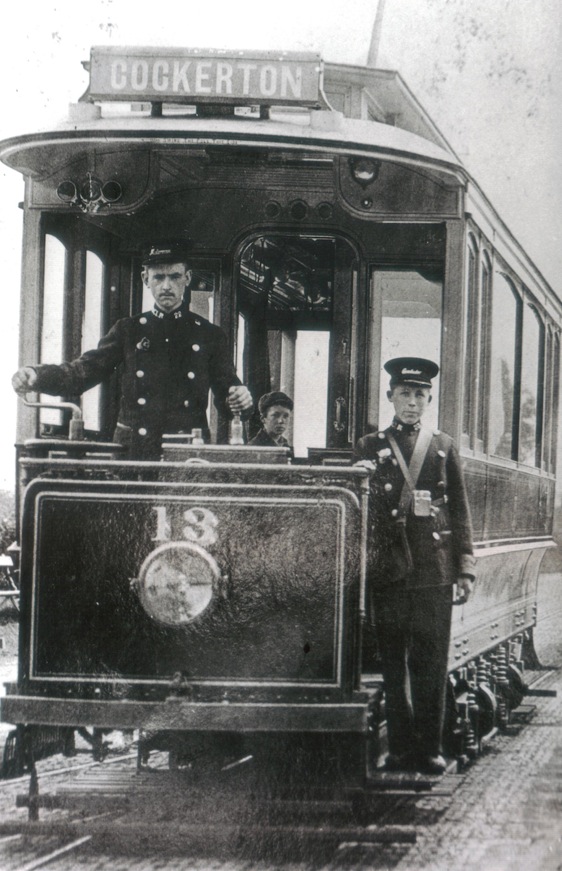
A motorman and a conductor pose for the camera with Tramcar No 13 at Cockerton — photo undated, but probably taken not long after the opening judging by the pristine condition of the tramcar. Photo courtesy of the Stephen Lockwood Collection.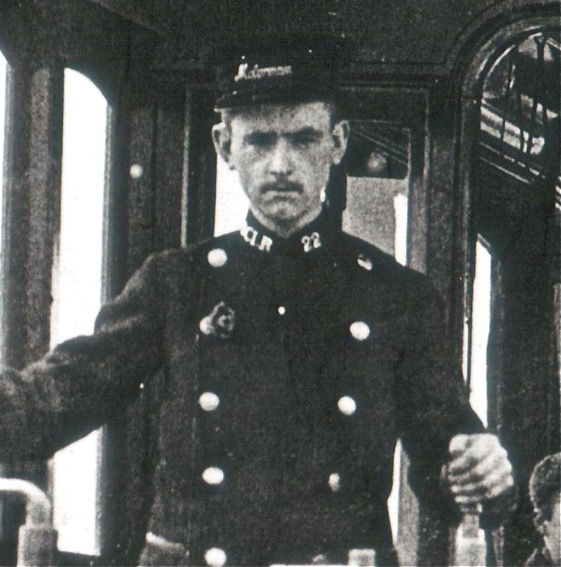
An enlargement of the above photograph showing the motorman and his collar insignia: employee number on the left-hand side ('22') and system initials — 'D C L R' — on the right-hand side.
Standard off-the-shelf script-lettering grade badges of the type used by Darlington Corporation Light Railways on tramcar crew caps — brass. Author's Collection.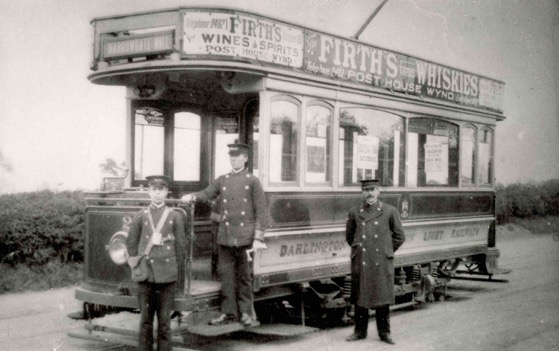
A conductor, a motorman and an inspector with Tramcar No 2 at the Eastbourne terminus — photo undated, but given the excellent condition of the tram, probably taken in 1904.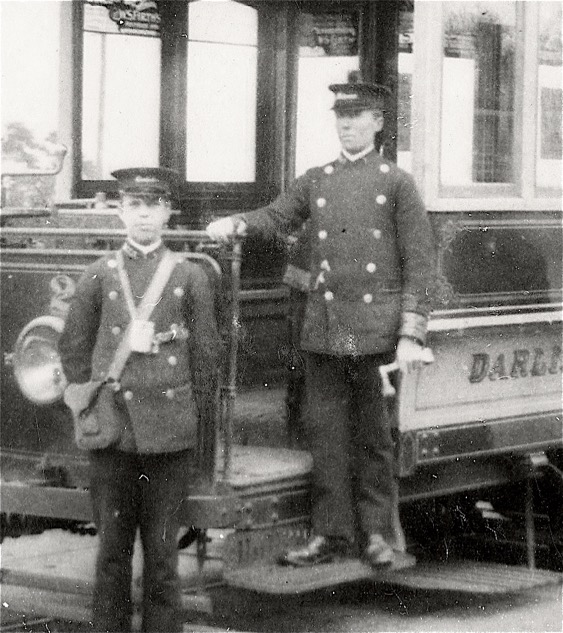
An enlargement of the above photograph showing the conductor and the motorman.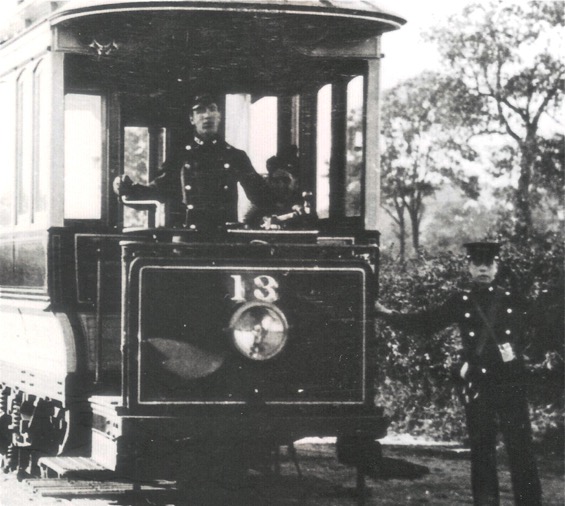
The crew of Tramcar No 13 at the Eastbourne terminus — photo undated, but probably taken shortly after the inauguration of electric services. Photo courtesy of the Stephen Lockwood Collection.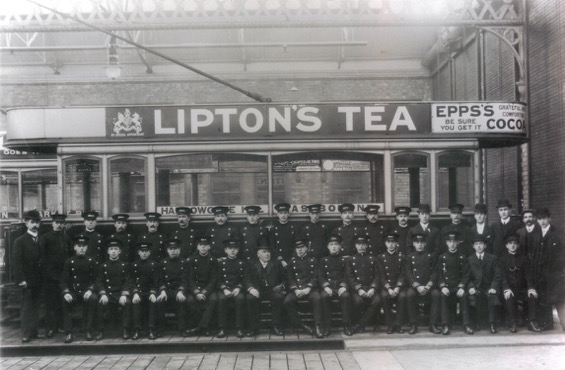
A staff photo taken at the depot at Freemans Place in April 1908. Photo courtesy of the Stephen Lockwood Collection.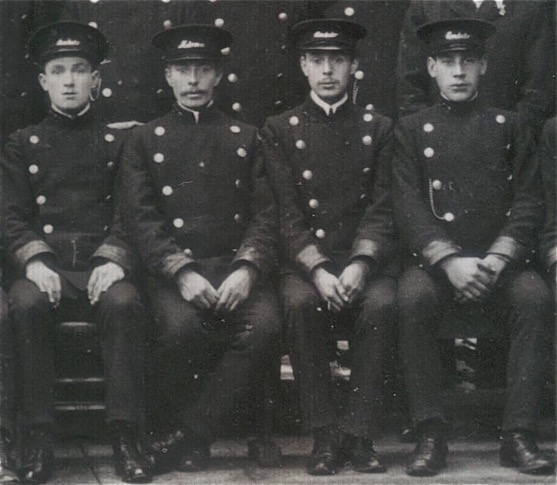
An enlargement of the above photograph showing three of the conductors and a motorman.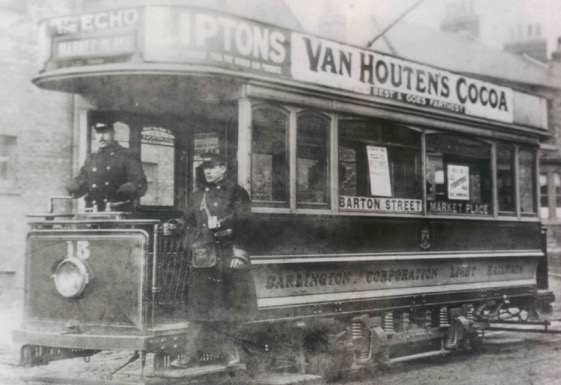
The crew of Tramcar No 15 pose for the cameraman at the Barton Street terminus shortly before the Great War. Both men are wearing double-breasted greatcoats, seemingly without badges of any kind. Photo courtesy of the Stephen Lockwood Collection.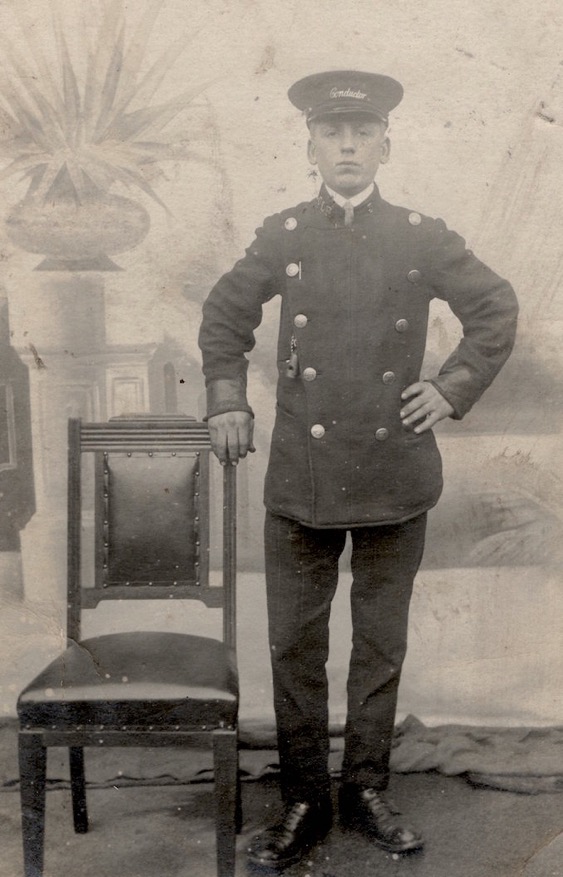
A rare studio portrait of a DCLR conductor, postally used on the 15th January 1912. The back is signed 'Arthur', which may well be the subject's name. Author's Collection.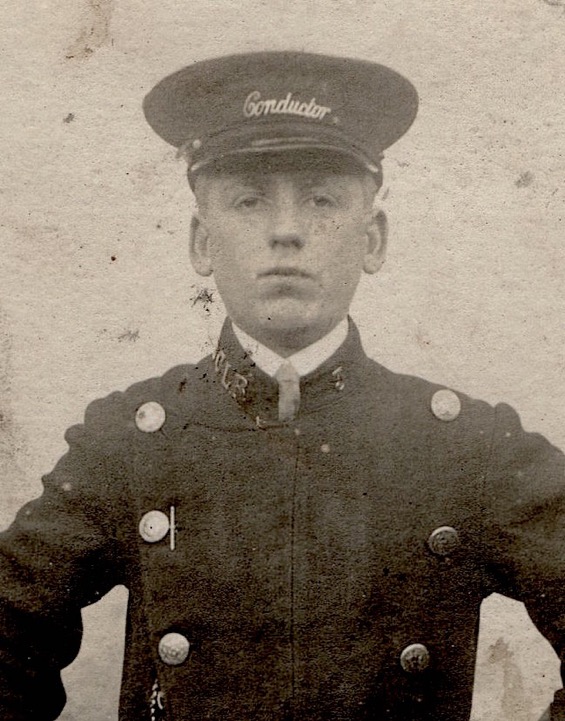
An enlargement of the above photograph showing details of the cap and collar insignia — 'D C L R' on the bearer's right-hand collar, and an employee number ('3') on the left.
Senior staff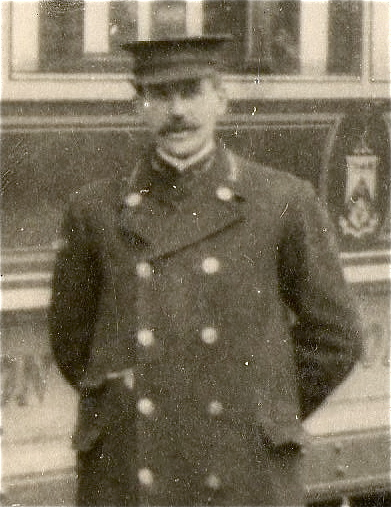
An enlargement of the early-Edwardian photograph of Tramcar No 2 above, showing the inspector. His overcoat and the stand-up collars of his jacket (underneath) both appear to carry his grade — 'Inspector' — in embroidered script lettering. In all probability, his cap also carries the same embroidered designation, though this cannot be made out on this particular photograph.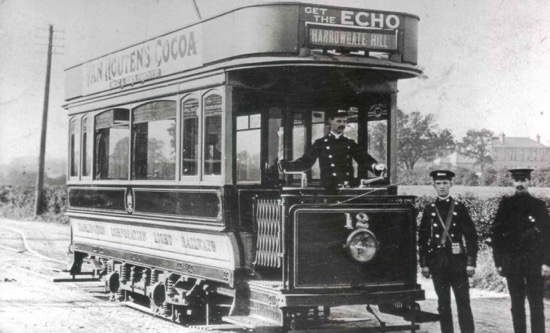
The crew of Tramcar No 12, together with an inspector, standing in sylvan surrounding at the terminus at Eastbourne — photo undated, but probably early-to-mid Edwardian. Photo courtesy of the Stephen Lockwood Collection.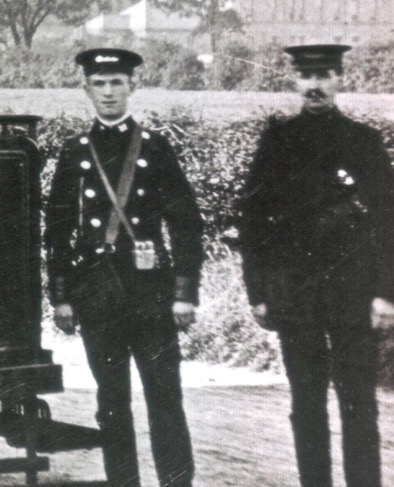
An enlargement of the above photograph showing the inspector (right).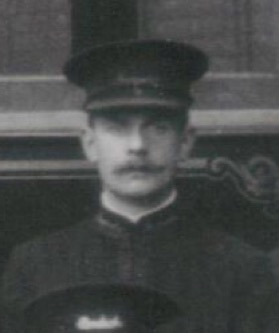
An enlargement of the 1908 staff photograph above showing an inspector — the embroidered script-lettering grade badges on his collars and cap can just be made out.
Female staff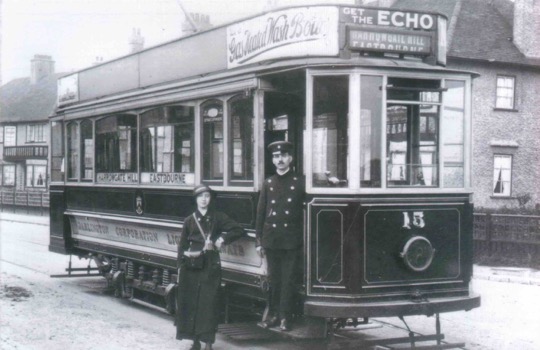
The crew of Tramcar No 15 pose for the camera at the terminus at Eastbourne — photo undated, but certainly taken during the Great War. Photo courtesy of the Stephen Lockwood Collection.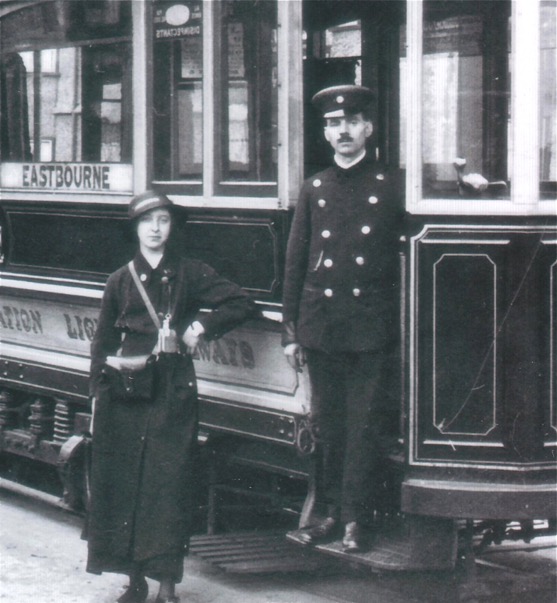
An enlargement of the above photograph showing the conductress and the motorman (Harry Auckland, later an inspector). Both the subjects are wearing a small round badge, the conductress on her right lapel and the motorman on his cap; it is possible, though by no means certain, that these were War Service badges. Photo courtesy of the Stephen Lockwood Collection.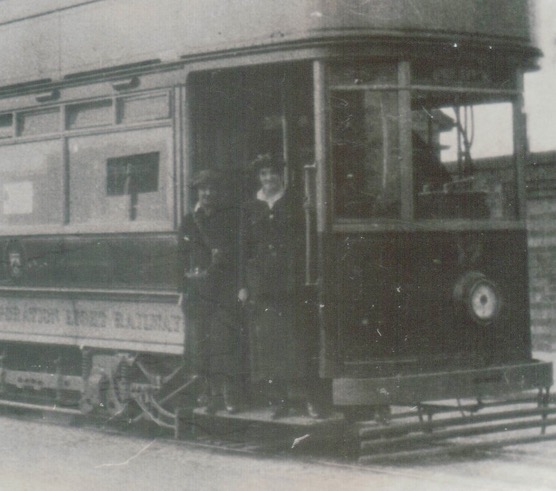
A Great War DCLR conductress, and possibly a motorwoman (she appears to be holding a controller handle), with Tramcar No 17 at the Harrowgate Hill terminus. Photo courtesy of the Stephen Lockwood Collection.